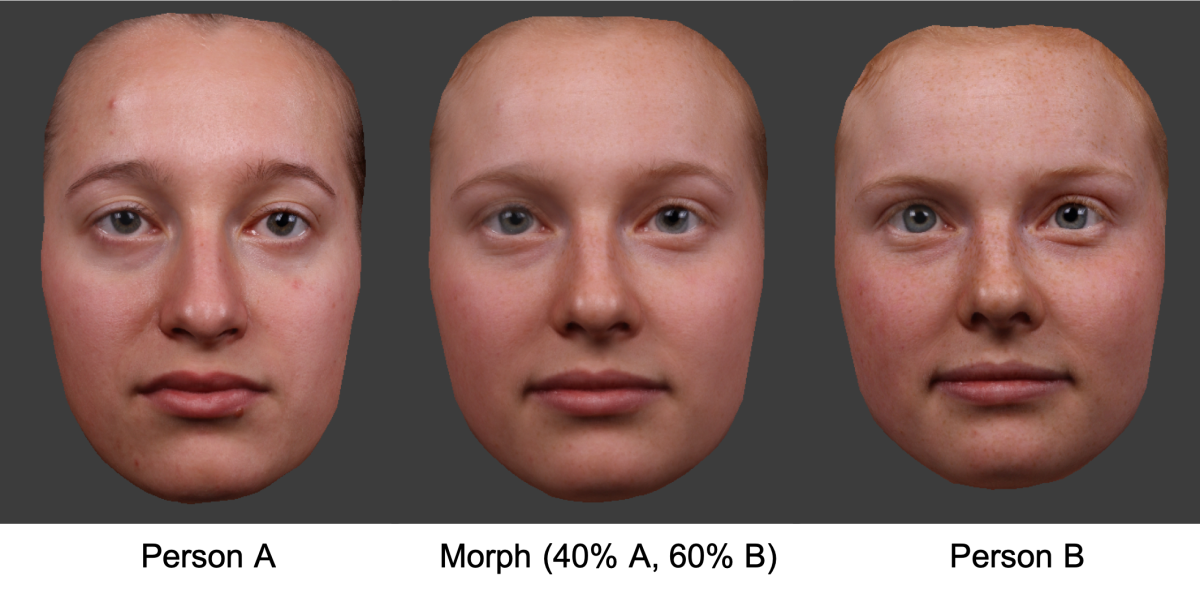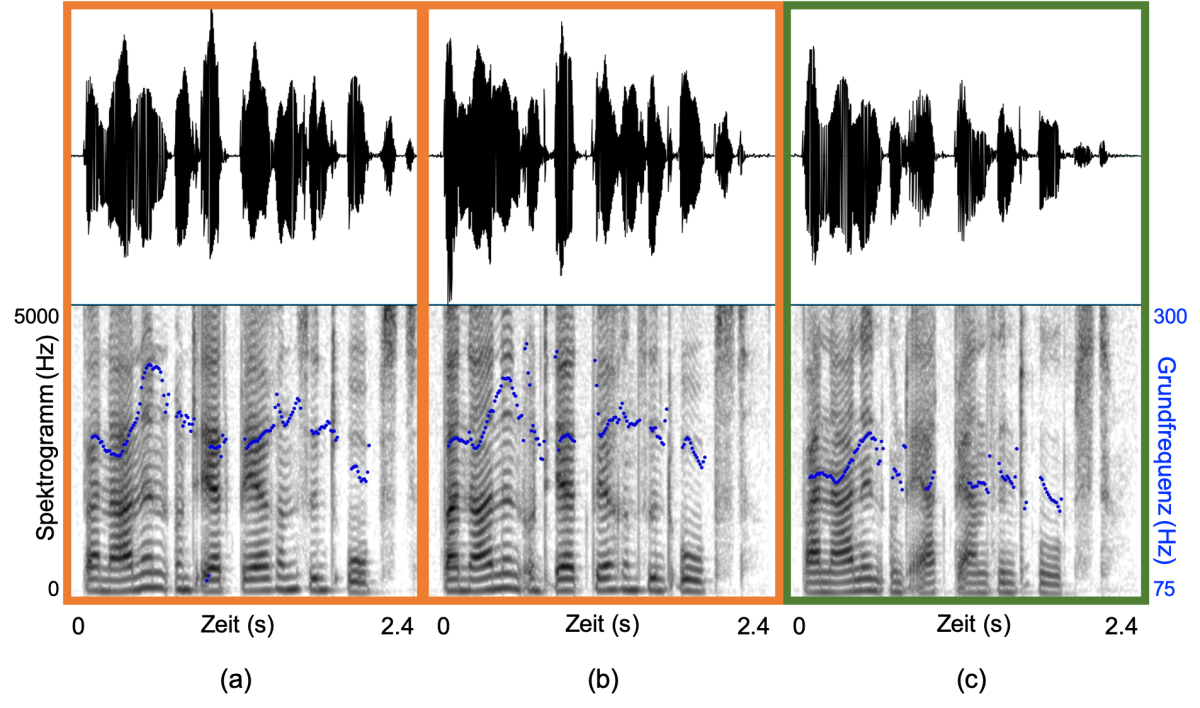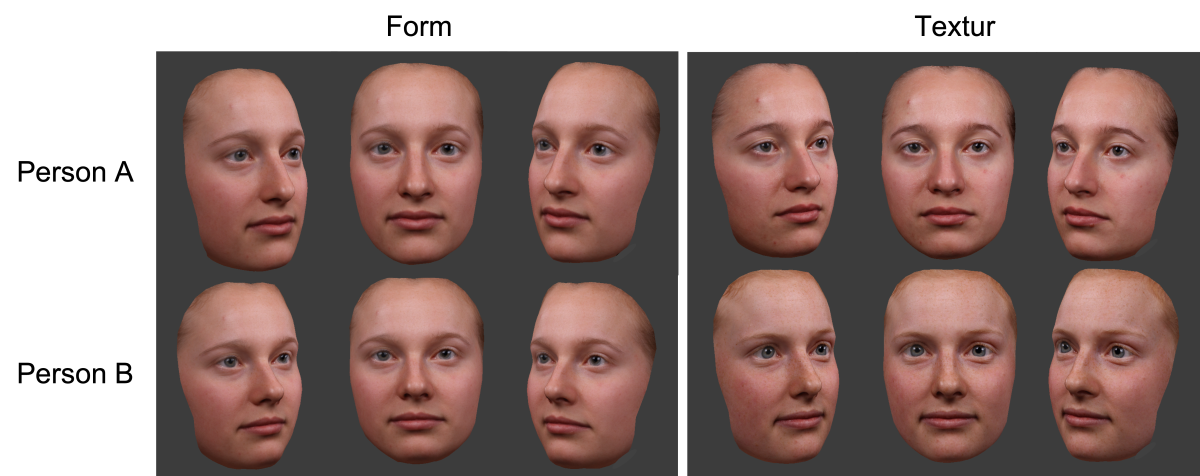Erkennen von Verwandtschaft zu sich Selbst und bei Anderen
Inwieweit können Menschen Verwandtschaftsbeziehungen erkennen? Wir vertrauen unbekannten Gesichtern eher, wenn diese uns selbst ähnlich sehen, und neuere Forschung zeigt, wie wir Verwandtschaft auch zwischen zwei unbekannten anderen Menschen (z. B. Geschwistern) erkennen können. Der Beitrag analysiert Signale und Mechanismen, die diese Fähigkeit ermöglichen, und bezieht sie auf weitere Aspekte der spontanen Eindrucksbildung über andere Menschen und des Verstehens Anderer.
“Du siehst deiner Schwester wirklich ähnlich”. “Ich habe meinen Bruder am Telefon mit meinem Vater verwechselt”. Klingen diese Aussagen für Sie bekannt? Aus unserer Erfahrung erwarten wir, dass Mitglieder einer Familie ähnliche Gesichter oder Stimmen haben, und dass wir Verwandtschaftsbeziehungen irgendwie visuell oder akustisch erkennen können. Das Erkennen von Verwandtschaft (Englisch kinship recognition) ist bei verschiedenen Tierarten bekannt. Verwandtschaft bedeutet für Menschen aber viel mehr – sie stellt ein wichtiges organisierendes Merkmal von Gesellschaften dar. Das Erkennen von engen und entfernten Verwandtschaftsbeziehungen kann uns helfen, andere besser zu verstehen, die eigene Identität in der Gemeinschaft zu finden oder erfolgreiche Kooperationen zu entwickeln. Trotz seiner Bedeutung weiß man bis heute aber recht wenig über die Mechanismen, Signale, oder Konsequenzen des Erkennens von Verwandtschaft. Wie erkennen wir genetische Verwandtschaft von Menschen in Gesichtern oder Stimmen?
Ein wichtiger Aspekt für das Erkennen von Verwandtschaft ist das Erkennen der Ähnlichkeit zu sich selbst (im Folgenden kurz: Selbstähnlichkeit). Die Wahrnehmung genetischer Verwandtschaft zwischen sich selbst und Anderen ist entscheidend für das soziale, elterliche oder sexuelle Verhalten. Um zu erforschen, wie Menschen Selbstähnlichkeit bei Gesichtern wahrnehmen, benutzen viele WissenschaftlerInnen digitale Mischungen (sogenannte Morphs) von Gesichtern (Bild 1). Menschen beurteilten Morphs zwischen einem fremden, unbekannten Gesicht und dem eigenen Gesicht als attraktiver und vertrauenswürdiger, verglichen mit einem Morph zwischen zwei fremden Gesichtern (DeBruine, 2002, 2004). Vor dem Hintergrund zahlreicher Befunde, nach denen Frauen Männern in vielen anderen Aspekten der sozialen Wahrnehmung tendenziell überlegen sind, ist es bemerkenswert, dass einige Studien darauf hinweisen, dass Männer Selbstähnlichkeit besser wahrnehmen können als Frauen. Diese Geschlechtsunterschiede fanden sich auch in neurowissenschaftlichen Studien, die berichten, dass selbstähnliche Gesichter Aktivierungen in einer Reihe von Gehirnregionen auslösten, unter anderem im rechten vorderen Gyrus cinguli – einem Areal, das mit Inhibition (Hemmung) in Verbindung gebracht wird (Platek & Kemp, 2009). Aufgrund der unsicheren Vaterschaft (“pater semper incertus est”; Lateinisch für „der Vater ist immer ungewiss“) könnte es für Männer evolutionär wichtiger sein, Verwandtschaft erkennen zu können. Diese Befunde könnten darauf hindeuten, dass die Selbstähnlichkeit eines Gesichts die wahrgenommene Unsicherheit über die Verwandtschaft insbesondere bei Männern hemmt. Die neuronale Verarbeitung von Gesichtern verwandter Personen scheint zudem der Verarbeitung des eigenen Gesichts ähnlicher zu sein als der Verarbeitung eines bekannten Gesichts einer (nicht verwandten) befreundeten Person. Dies könnte dafür sprechen, dass das Erkennen von Verwandtschaft neuronal über Selbstähnlichkeit (die Verarbeitung von zu sich Selbst referenzierten phänotypischen Merkmalen) kodiert wird (Platek et al., 2004).
 Bild 1: Beispielhafte Illustration eines eigenen Gesichts (links, Person A, Alter 20 Jahre) und eines unbekannten Gesichts desselben Geschlechts und vergleichbaren Alters (rechts; Person B, Alter 21 Jahre), und eines Morphs zwischen diesen beiden Gesichtern (Mitte), der in diesem Beispiel 40 % von Person A und 60 % von Person B enthält.
Bild 1: Beispielhafte Illustration eines eigenen Gesichts (links, Person A, Alter 20 Jahre) und eines unbekannten Gesichts desselben Geschlechts und vergleichbaren Alters (rechts; Person B, Alter 21 Jahre), und eines Morphs zwischen diesen beiden Gesichtern (Mitte), der in diesem Beispiel 40 % von Person A und 60 % von Person B enthält.
Der Geruchssinn dürfte für die Verwandtschaftserkennung ebenfalls wichtig sein: Versuchspersonen konnten beispielsweise ihre gleichgeschlechtlichen Geschwister besser am Geruch erkennen als enge Freunde. Zudem zeigten sich im Gehirn der Versuchspersonen Aktivierungsunterschiede zwischen Geschwistern und Freunden unabhängig von einer bewussten Identifikation ihrer Geschwister. Dies könnte darauf hinweisen, dass die olfaktorische Verwandtschaftserkennung weitgehend unbewusst abläuft, und dass die Verwandtschaftserkennung vermutlich eine in der Evolution alte und grundlegende soziobiologische Funktion hat (Lundström et al., 2009).
Was die Erkennung von Stimmen angeht, zeigen Tierstudien, dass bestimmte Affenarten wie Mandrille den Stimmen genetisch verwandter Artgenossen mehr Aufmerksamkeit zuwenden, unabhängig davon ob sie diese Stimmen kennen oder nicht (Levrero et al., 2015). Singvögel zeigen gegenüber Stimmen nicht verwandter Vögel stärkere Aggressionen. Dies weist darauf hin, dass sie verwandte von nicht verwandten Artgenossen an der Singstimme unterscheiden können (Akçay et al., 2013). Vergleichbaren Studien mit menschlichen Stimmen existieren bisher nicht, die Tierstudien lassen aber vermuten, dass die Evolution wahrscheinlich auch beim Menschen ein ausgefeiltes System nonverbaler auditorischer Kommunikation hervorgebracht hat (Frühholz & Schweinberger, 2021), welches auch eine effiziente auditorische Verwandtschaftserkennung ermöglichen sollte. Unsere derzeitige Forschung beschäftigt sich damit, ob und wie Menschen Selbstähnlichkeit und Verwandtschaft bei Stimmen erkennen können.
Über die Erkennung von
Selbstähnlichkeit hinausgehend ist auch das Erkennen von Verwandtschaft zwischen fremden Personen wichtig für das Verstehen anderer im Kontext sozialer Beziehungen. Verschiedene Arbeiten zeigen, dass Menschen überzufällig gut erkennen, ob zwei Porträtfotos fremder Menschen Geschwister oder aber nicht verwandte Personen zeigen (Dal Martello et al., 2006). In dieser Studie wurden jungen erwachsenen ProbandInnen jeweils Paare von Gesichtern am Computer gezeigt, von denen die Hälfte zwei Geschwister und die andere Hälfte zwei nicht verwandte Personen mit vergleichbarem Altersunterschied zeigten. Die ProbandInnen waren vorher informiert worden, dass die Hälfte der Paare genetische Geschwister zeigten. Sie sollten für jedes Paar entscheiden, ob es Geschwister zeigte oder nicht. Im Mittel lagen die ProbandInnen bei über 70 % der Paare, und damit deutlich über dem Zufallsniveau von 50 %, mit ihrer Einschätzung richtig. Menschliche Beobachter können auch Verwandtschaft zwischen Eltern und Kindern bei unbekannten Gesichtern (Kaminski et al., 2012) und sogar bei Gesichtern von Rhesusaffen erkennen (Kazem et al., 2018). Die Fähigkeit, Verwandtschaft zu erkennen, wurde bereits im Alter von fünf Jahren nachgewiesen, verbessert sich aber im weiteren Verlauf der Entwicklung noch (Dal Martello et al., 2015). Bild 2: Beispiele für Stimmen von zwei eineiigen weiblichen Zwillingen (a und b; Alter 21 Jahre) und einer nicht verwandten weiblichen Sprecherin ähnlichen Alters (c; Alter 19 Jahre). Die Beispiele zeigen den Schalldruckverlauf über die Zeit (oben) und ein Sprachspektrogramm (unten) der Äußerung „Bananen und Erdbeeren sind Obst“. Bitte beachten Sie die unterschiedliche Frequenzskalierung für das Sprachspektrogramm (links, und in schwarz) und die Frequenz der Grundfrequenzkontur (rechts, und in blau).
Bild 2: Beispiele für Stimmen von zwei eineiigen weiblichen Zwillingen (a und b; Alter 21 Jahre) und einer nicht verwandten weiblichen Sprecherin ähnlichen Alters (c; Alter 19 Jahre). Die Beispiele zeigen den Schalldruckverlauf über die Zeit (oben) und ein Sprachspektrogramm (unten) der Äußerung „Bananen und Erdbeeren sind Obst“. Bitte beachten Sie die unterschiedliche Frequenzskalierung für das Sprachspektrogramm (links, und in schwarz) und die Frequenz der Grundfrequenzkontur (rechts, und in blau).
Das Erkennen von Verwandtschaft in Gesichtern dürfte sich zum Großteil aus der Ähnlichkeit zwischen Gesichtern erklären lassen: In einer Studie beurteilte eine ProbandInnengruppe die genetische Verwandtschaft von Gesichterpaaren; eine zweite ProbandInnengruppe sollte die Ähnlichkeit der Gesichter einschätzen und war nicht darüber informiert, dass manche der Paare Geschwister zeigten. Die wahrgenommene Ähnlichkeit der Gesichter in der zweiten Gruppe korrelierte dabei bemerkenswert gut mit der tatsächlichen Verwandtschaft, und mit der Wahrscheinlichkeit, mit der die erste Gruppe ein Gesichterpaar als verwandt einschätzte (Maloney & Dal Martello, 2006). Um erstmals zu untersuchen, inwieweit Menschen auch genetische Verwandtschaft auf der Basis unbekannter Stimmen erkennen können, haben wir aktuell begonnen, eine Datenbank von Stimmen von Zwillingen und Geschwistern zu erstellen (Bild 2).
Unter der Annahme, dass das Erkennen von Verwandtschaft auf Basis von Gesichtern (und möglicherweise auch Stimmen) überzufällig gut gelingt, stellt sich die Frage, welche Hinweise zum Erkennen von Verwandtschaft genutzt werden. Ein relevantes Experiment wurde mit unbekannten Gesichtern durchgeführt, wobei verschiedene Teile des Gesichts jeweils maskiert und nicht sichtbar waren (Dal Martello et al., 2006). Die Ergebnisse zeigten, dass die obere Gesichtshälfte und insbesondere die Augenregion annähernd genauso viel Information über Verwandtschaft enthielt wie das komplette Gesicht, wohingegen die untere Gesichtshälfte vergleichsweise uninformativ bezüglich der Verwandtschaft war. Eine Folgestudie zeigte, dass eine Drehung (Rotation) und sogar eine 180°
Inversion („auf-den-Kopf stellen“) der Gesichter die Erkennung der Verwandtschaft nicht beeinträchtigte (Dal Martello et al., 2015). Dies ist ein durchaus überraschendes und bislang nicht vollständig verstandenes Ergebnis, da bekannt ist, dass eine
Inversion sowohl die ganzheitliche Wahrnehmung als auch die Erkennung von Gesichtern dramatisch beeinträchtigen. Eine weitere Studie untersuchte die Rolle von Forminformationen (z. B. Verhältnis von Breite zu Höhe des Gesichts, Augenabstand oder Abstand von Nase zu Mund) im Vergleich zu Informationen zur
Oberflächenreflektanz (z. B. Hautfarbe und -pigmentierung). Die Autoren nutzten 3D-Bilder von Gesichtern, die entweder unverändert waren, nur Information über
Oberflächenreflektanz enthielten, oder nur Forminformation enthielten. Die Ergebnisse lassen vermuten, dass sowohl Form- als auch Reflektanzinformationen für sich genommen zum Erkennen von Verwandtschaft beitragen (Fasolt et al., 2019) (siehe Bild 3 für Beispiele, bei denen der irrelevante Informationstyp kontrolliert wurde).  Bild 3: Beispielhafte Illustration für parameterspezifische Informationen von Person A (oben) oder Person B (unten). Parameterspezifische Information ist separat gezeigt für Form, wobei Texturinformation zwischen Personen standardisiert wurde (linke Hälfte) oder für Textur, wobei Forminformation zwischen Personen standardisiert wurde. Die drei benachbarten Bilder illustrieren lediglich drei Blickwinkel auf dieselbe 3D-Objektdatei. Bitte beachten Sie, dass „Person A“ und „Person B“ hier Informationen zu denselben Identitäten zeigen, die auch in Bild 1 abgebildet sind. Bitte beachten Sie auch, dass wir den Begriff “Textur” hier als Synonym zum Begriff „Oberflächenreflektanz verwenden.
Bild 3: Beispielhafte Illustration für parameterspezifische Informationen von Person A (oben) oder Person B (unten). Parameterspezifische Information ist separat gezeigt für Form, wobei Texturinformation zwischen Personen standardisiert wurde (linke Hälfte) oder für Textur, wobei Forminformation zwischen Personen standardisiert wurde. Die drei benachbarten Bilder illustrieren lediglich drei Blickwinkel auf dieselbe 3D-Objektdatei. Bitte beachten Sie, dass „Person A“ und „Person B“ hier Informationen zu denselben Identitäten zeigen, die auch in Bild 1 abgebildet sind. Bitte beachten Sie auch, dass wir den Begriff “Textur” hier als Synonym zum Begriff „Oberflächenreflektanz verwenden.
Verglichen mit den recht umfangreichen Studien zu Gesichtern, wissen wir wenig über die Hinweise zum Erkennen von Verwandtschaft in der menschlichen Stimme (z. B. Grundfrequenz, Klangfarbe, Sprechrate). Zusätzlich zur Untersuchung von Geschlechtsunterschieden bei der akustischen Erkennung von Verwandtschaft wäre es auch interessant zu bestimmen, inwieweit Unterschiede im kulturellen Hintergrund oder der Muttersprache von HörerInnen, oder Unterschiede in auditorischen Fertigkeiten einschließlich Musikalität oder musikalischem Training einen Einfluss auf das akustische Erkennen der Verwandtschaft von SprecherInnen haben könnten.
Welche Bedeutung hat die Verwandtschaftserkennung für die Fähigkeit, Andere zu verstehen? Verglichen mit anderen nonverbalen Informationen, etwa über Emotionen, über die Identität von Personen, oder Eindrücke über Persönlichkeitsmerkmale, sind Verwandtschaftsinformationen trotz ihrer Bedeutung für das Verstehen Anderer in der Forschung bisher vernachlässigt worden. Der einflussreichen social brain-Hypothese zufolge könnten soziale Interaktionen die wichtigste Triebfeder für die Entwicklung des menschlichen Gehirns darstellen – und zwar sowohl in der individuellen Gehirnentwicklung als auch in der Evolution. Wir schlagen vor, dass (1) erfolgreiche soziale Interaktionen sich durch gute Vorhersagen des bevorstehenden Verhaltens von KommunikationspartnerInnen auszeichnen, dass (2) ein besseres Verstehen Anderer bessere Vorhersagen in solchen sozialen Interaktionen ermöglicht, und dass (3) die oben erwähnten Arten nonverbaler Informationen zum Verstehen und Vorhersagen des Verhaltens von KommunikationspartnerInnen beitragen können. Für korrekte Vorhersagen der unmittelbaren Zukunft kann beispielsweise die Identifikation des Gegenübers von entscheidender Bedeutung sein: Es macht einen Unterschied, ob auf mich gerichtete Wut von meinem Kind oder einer vorgesetzten Person, meinem Geschwister oder einem fremden Menschen ausgeht.
Die Theorie des predictive coding spezifiziert, wie das Gehirn durch eine dynamische Aktualisierung seines mentalen Modells der Umwelt funktioniert. Obwohl diese Theorie einflussreich für die Erklärung der Funktionsweise des Gehirns ist, versuchen bisher nur wenige Arbeiten, die predictive coding-Theorie mit Modellen der Personenwahrnehmung und sozialen Interaktion zu integrieren (Trapp et al., 2018). Dynamische emotionale Signale können sich während einer einzelnen Interaktion schnell ändern, etwa wenn wir lachen, die Stirn runzeln oder wütend werden. Im Gegensatz dazu sind andere Signale (z. B. zu Alter, Identität, Verwandtschaft, oder Persönlichkeitseindrücken) vergleichsweise zeitstabil. Diese zeitstabilen Merkmale einer Person beschreiben in gewisser Weise die mögliche Bandbreite der Optionen für künftige Handlungen dieser Person besser als deren tatsächliches momentanes Verhalten. Gleichzeitig können zeitstabile nonverbale Signale (und damit auch Verwandtschaftssignale) die Interpretation dynamischer emotionaler Signale kontinuierlich beeinflussen, und so die Vorhersage künftiger Handlungen von KommunikationspartnerInnen optimieren.
Da die menschliche Verwandtschaftserkennung noch ein relativ junges Forschungsgebiet darstellt, dürfen wir in Zukunft spannende Studien erwarten, die die Rolle der Verwandtschaftserkennung für soziale Interaktionen und letztlich das Verstehen Anderer weiter untersuchen. Es wird zu sehen sein, wie die Evolution einerseits und die individuelle Lernerfahrung über die Lebensspanne andererseits die Verarbeitung verschiedener sozialer Signale beeinflussen können, und wie die Kombination dieser Faktoren die Effizienz sozialer Interaktionen optimieren kann. Ein erfolgreicher Umgang mit den großen Herausforderungen der Menschheit im 21. Jahrhundert erfordert vielleicht auch eine neue Ebene des Verstehens Anderer. Im Jahr 1955 – damals unter dem Eindruck des zweiten Weltkriegs und der Bedrohung der nuklearen Auslöschung – eröffnete Edward Steichen eine bemerkenswerte Ausstellung im New York Museum of Modern Art, in der der unerreichte Fotograf ein umfassendes Porträt der Menschheit angestrebt hatte. Heute ist die berühmte Ausstellung Teil des Weltgedächtnis-Programms der UNESCO. Steichens Name der Ausstellung – The Family of Man – verdeutlicht in unseren Augen, wie zentral das Konzept der Verwandtschaft für das Verstehen Anderer ist.
Bildquellen
Bild 1: Eigentum der Autoren mit freundlichem Dank an die abgebildeten Personen für die schriftliche Zustimmung.
Bild 2: Eigentum der Autoren mit freundlichem Dank an die sprechenden Personen für die schriftliche Zustimmung.
Bild 3: Eigentum der Autoren.
Literaturverzeichnis
Akçay, Ç., Swift, R. J., Reed, V. A., & Dickinson, J. L. (2013). Vocal kin recognition in kin neighborhoods of western bluebirds. Behavioral Ecology, 24, 898-905. https://doi.org/10.1093/beheco/art018
Dal Martello, M. F., DeBruine, L. M., Maloney, L. T., & Generale, P. (2015). Allocentric kin recognition is not affected by facial inversion. Journal of Vision, 15, 1–11. https://doi.org/10.1167/15.13.5.doi
Dal Martello, M. F., Maloney, L. T., & Generale, P. (2006). Where are kin recognition signals in the human face? Journal of Vision, 6, 1356–1366. https://doi.org/10.1016/j.visres.2008.09.025
DeBruine, L. M. (2002). Facial resemblance enhances trust. Proceeding of the Royal Society of London B: Biological Sciences, 2, 1307–1312. https://doi.org/10.1098/rspb.2002.2034
DeBruine, L. M. (2004). Resemblance to self increases the appeal of child faces to both men and women. Evolution and Human Behavior, 25, 142–154. https://doi.org/10.1016/j.evolhumbehav.2004.03.003
Fasolt, V., Holzleitner, I. J., Lee, A. J., Shea, K. J. O., & DeBruine, L. M. (2019). Contribution of shape and surface reflectance information to kinship detection in 3D face images. Journal of Vision, 19, 1–9. https://doi.org/1 0.1167/19.12.9
Frühholz, S., & Schweinberger, S. R. (2021). Nonverbal auditory communication – Evidence for integrated neural systems for voice signal production and perception. Progress in Neurobiology. https://doi.org/10.1016/j.pneurobio.2020.101948
Kaminski, G., Gentaz, E., & Mazens, K. (2012). Development of children’ s ability to detect kinship through facial resemblance. Animal Cognition, 421–427. https://doi.org/10.1007/s10071-011-0461-y
Kazem, A. J. N., Barth, Y., Pfefferle, D., Kulik, L., & Widdig, A. (2018). Parent – offspring facial resemblance increases with age in rhesus macaques. Proceeding of the Royal Society of London B: Biological Sciences, 285, 2–7. http://dx.doi.org/10.1098/rspb.2018.1208
Maloney, L. T., & Dal Martello, M. F. (2006). Kin recognition and the perceived facial similarity in children. Journal of Vision, 6, 1047-1056. https://doi.org/10.1167/6.10.4
Levrero, F., Herbert, A., Lawabi, I., Courtiol, A., Willaume, E., Kappeler, P. M., & Charpentier, M. J. E. (2015). Social shaping of voices does not impair phenotype matching of kinship in mandrills. Nature Communications, 6, 1–7. https://doi.org/10.1038/ncomms8609
Lundström, J. N., Boyle, J. A., Zatorre, R. J., & Jones-Gotman, M. (2009). The Neuronal Substrates of Human Olfactory Based Kin Recognition. Human Brain Mapping, 30, 2571–2580. https://doi.org/10.1002/hbm.20686
Platek, S. M., & Kemp, S. M. (2009). Is family special to the brain? An event-related fMRI study of familiar, familial, and self-face recognition. Neuropsychologia, 47, 849–858. https://doi.org/10.1016/j.neuropsychologia.2008.12.027
Platek, S. M., Raines, D. M., Gallup, G. G., Mohamed, F. B., Thomson, J. W., Myers, T. E., Panyavin, I. S., Levin, S. L., Davis, J. A., Fonteyn, L. C. M., & Arigo, D. R. (2004). Reactions to children’s faces: Males are more affected by resemblance than females are, and so are their brains B. Evolution and Human Behavior, 25, 394–405. https://doi.org/10.1016/j.evolhumbehav.2004.08.007
Trapp, S., Schweinberger, S. R., Hayward, W. G., & Kovács, G. (2018). Integrating predictive frameworks and cognitive models of face perception. Psychonomic Bulletin & Review, 25, 2016–2023. https://doi.org/10.3758/s13423-018-1433-x


